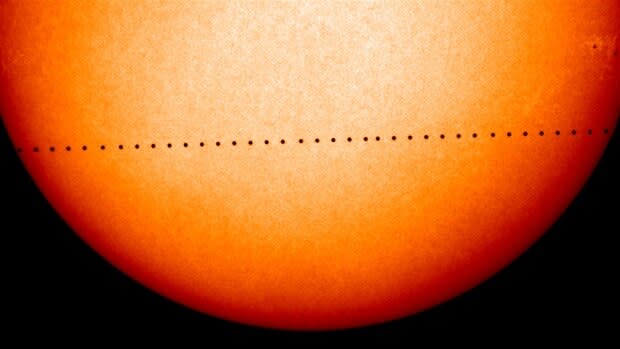Mercury will cross the face of the sun. Here's how to watch safely
A rare event will take place on Monday — Mercury will pass in front of the sun, an event called a "transit" that will be visible across the country, should the weather comply.
Here on Earth, we can only see transits of Mercury and Venus, the only two planets between us and the sun. Transits of Mercury occur on average 13 times per century. The last one was in May 2016; the next will be on Nov. 13, 2032. The last time Venus transited was in 2012; the next won't be until 2117.
We don't see these events more often because those planets have orbital paths that are inclined compared to that of Earth. This means that they don't always end up directly between us and the sun.
If you want to observe Mercury's transit — first things first — never look directly at the sun without appropriate protection. Like a solar eclipse, a special filter is required in order to prevent eye damage. However, using those glasses you may have saved from the "Great American Eclipse" in 2017 won't do.
It's not because they won't protect you, but Mercury — a planet that is only slightly larger than our moon and which lies roughly 50 million kilometres from Earth — appears as a tiny dot against the sun, which is 300 times larger. You're going to need a magnification of at least 50 times to see it.

The good news is, many astronomical groups will gather — with their telescopes and proper filters — to watch the event, providing it's not cloudy.
The first contact, or the moment the edge of the planet first begins to cross the sun, will occur at 7:35 a.m. ET. The time of greatest transit, the halfway point, occurs at roughly 10:20 a.m., and the transit will end at roughly 1:04 p.m.
From British Columbia across the Prairies to northwestern Ontario and the northern tip of Quebec, the transit will have already begun by sunrise. (The same goes for most of the Yukon, Northwest Territories and Nunavut). The rest of the country will be able to enjoy the entire 5.5-hour show.
The Royal Astronomical Society of Canada has a list of events happening across the country, including in Calgary, Saskatoon, Montreal, Ottawa and St. John's.
Several universities, such as York University in Toronto, Western University in London, Ont., the University of Waterloo, in Kitchener-Waterloo, Ont. and the University of Saskatchewan, in Saskatoon will also be hosting "watch parties." There is also a viewing party at Planétarium Rio Tinto Alcan de Montreal.
If the weather doesn't co-operate, you can always watch it online, on Slooh's YouTube channel and The Virtual Telescope Project.
While you won't notice any difference in the light output from the sun, these types of transits are primarily used to find planets around distant stars. When a planet transits its star, its light dims ever so slightly, allowing astronomers to detect the orbiting world.

